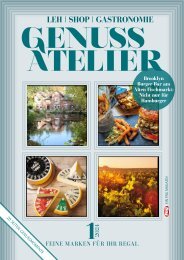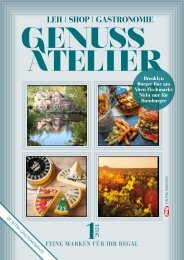Create successful ePaper yourself
Turn your PDF publications into a flip-book with our unique Google optimized e-Paper software.
<strong>pro</strong>cessing<br />
Goodbye, Salmonella: Bacteria-<br />
Free Through Treatment with<br />
Infrared Light<br />
Food safety is a crucially important issue in<br />
the pet food industry. The EU repeatedly<br />
reports <strong>pro</strong>duct recalls due to salmonellacontaminated<br />
animal feed, which must<br />
therefore be subjected to thorough<br />
treatments and to inspections to ensure<br />
that they are safe for consumption.<br />
Thermal <strong>pro</strong>cesses are commonly<br />
used in the food industry to reliably<br />
kill microorganisms. When selecting<br />
the ap<strong>pro</strong>priate <strong>pro</strong>cess, however, it is<br />
important to consider the effects of heat<br />
on the stability of the <strong>pro</strong>duct to be<br />
treated.<br />
With their patented FoodSafety-IRD<br />
(Infrared Rotary Drum), Kreyenborg,<br />
which specializes in bulk-solids, offers<br />
system components that in addition to<br />
drying and roasting food can sterilize<br />
and pasteurize bulk food or feed with<br />
greater care. Microorganisms such as<br />
salmonellae, E. coli, enterobacteria, mold<br />
or yeast fungi are killed reliably and the<br />
shelf- and storage life of the <strong>pro</strong>ducts are<br />
thus <strong>pro</strong>longed. This infrared <strong>pro</strong>cess can<br />
also kill insects and their larvae and eggs<br />
with certainty. Germ reduction achieved<br />
by the FoodSafety-IRD corresponds to a<br />
Log5 validation.<br />
The advantage of the FoodSafety-IRD<br />
lies in the operating principle of infrared<br />
light, conducting energy directly into<br />
the <strong>pro</strong>duct core, heating the material<br />
from the inside, out. This is unlike other<br />
thermal <strong>pro</strong>cesses, such as hot air dryers,<br />
which require hours to heat the <strong>pro</strong>duct,<br />
and does it in reverse – from the outside<br />
to the inside. The FoodSafety-IRD heats<br />
the <strong>pro</strong>duct core in a matter of minutes,<br />
resulting in significantly shorter dwelltimes.<br />
Working principle: Rotary<br />
motion with infrared-light<br />
technology<br />
The infrared <strong>pro</strong>cess can be illustrated by<br />
means of a cross-sectional view. The pet<br />
food to be post-<strong>pro</strong>cessed is continuously<br />
conveyed into the rotary drum by<br />
means of a feeding unit. The <strong>pro</strong>duct is<br />
transported from the inlet through the<br />
rotary drum to the outlet via a welded-in<br />
helix conveyor and is constantly mixed by<br />
the rotational movement. Simultaneously,<br />
the material is exposed to infrared light,<br />
thus heating entire particles, and when<br />
necessary, water can be sprayed onto the<br />
<strong>pro</strong>duct. When applied, this fine water<br />
mist has an additional sterilizing function,<br />
since bacteria reduction is enhanced at<br />
the moment of surface evaporation of the<br />
mist. This in addition creates a <strong>pro</strong>tective<br />
re-cooling effect. Infrared light has the<br />
advantage of being able to treat even<br />
<strong>pro</strong>ducts with a low water content.<br />
Process preserves color, taste,<br />
consistency and ingredients<br />
The decisive factor for a highly<br />
homogeneous <strong>pro</strong>duct appearance is<br />
this constant rotation and movement, as<br />
Managing Director Jan Hendrik Ostgathe<br />
explains: "In a belt-dryer, for example,<br />
the <strong>pro</strong>duct remains in one place for<br />
a longer period of time; this can lead<br />
to uneven nests forming that <strong>pro</strong>mote<br />
mold growth. By contrast, the constant<br />
rotational movement inside our infrared<br />
rotary drum dries the material evenly. This<br />
gentle <strong>pro</strong>cess preserves the color, flavor,<br />
consistency and the valuable ingredients<br />
of the <strong>pro</strong>duct."<br />
The Foodsafety-IRD has four temperature<br />
zones which can be set independently<br />
according to the <strong>pro</strong>duct, and which<br />
adjust themselves automatically, based<br />
on the recipe stored in the control<br />
system. The <strong>pro</strong>duct temperature<br />
remains constant, and overheating<br />
is thus avoided. Depending on the<br />
desired <strong>pro</strong>cess – in the case of pet food<br />
this would be mainly sterilization and<br />
pasteurization, but drying or roasting,<br />
as for nuts, is also possible – ap<strong>pro</strong>priate<br />
<strong>pro</strong>duct temperature and dwell-time<br />
must be selected. Temperatures of 80 to<br />
200 degrees Celsius and above can be<br />
achieved in the FS-IRD.<br />
Photos: ©Kreyenborg<br />
Cross-sectional view: The rotating drum of the FoodSafety-IRD is constantly in motion,<br />
ensuring uniform exposure to the infrared light.<br />
Stand-alone solution, or<br />
integrated module<br />
Kreyenborg supplies the FoodSafety-IRD<br />
as a plant component for its customers,<br />
but also offers turn-key solutions.<br />
Sterilization and pasteurization usually<br />
involve stand-alone solutions, requiring<br />
the necessary equipment, i.e. upstream<br />
and downstream conveyor technology,<br />
<strong>pro</strong>duct cooling and big-bag handling<br />
26<br />
Technology & Marketing


















